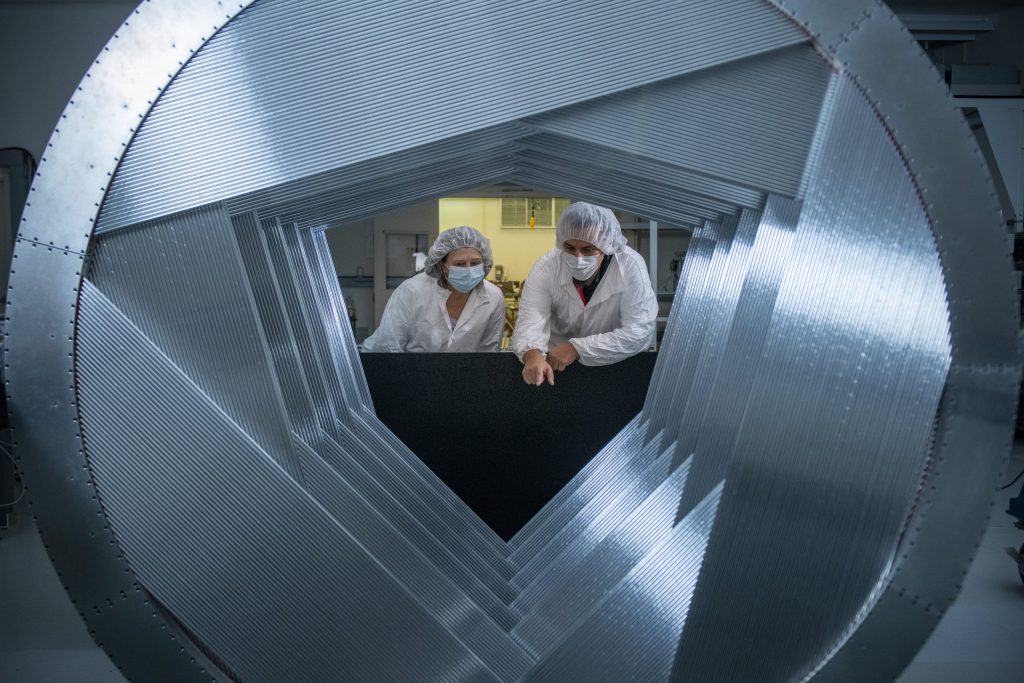Scientists and engineers from more than 50 countries collaborate with the U.S. Department of Energy’s Fermi National Accelerator Laboratory to develop state-of-the-art technologies and solve the mysteries of matter, energy, space and time.
Here is a look at 10 ways they advanced science and technology in 2022. Fermilab and its partners:
1.) Published results that made news in the scientific community — and beyond
In 2022, Fermilab scientists co-authored more than 600 scientific articles. The CMS and ATLAS collaborations released the results of comprehensive measurements of the properties of the Higgs particle, which made the cover of the journal Nature. The issue also included a collection of reviews and commentaries devoted to the 10 years of research since the discovery of the particle. The CDF collaboration announced the most precise measurement of the mass of the W boson, a result that made the cover of the journal Science. The MicroBooNE collaboration set stringent constraints on the existence of a sterile neutrino, following up on earlier neutrino oscillation measurements published in the journal Physical Review Letters this year.
Using the lab’s Integrable Optics Test Accelerator, researchers at Fermilab successfully demonstrated a new technique called optical stochastic cooling to create better, denser particle beams. The DESI collaboration created the largest and most detailed three-dimensional-map of the universe. The South Pole Telescope collaboration helped record the first image of the black hole at the heart of our galaxy. A collaboration of scientists involving Fermilab published the first experimental tests of quantum gravity models, a result that made the cover of the journal Nature. Fermilab scientists also co-authored summaries of the two-year-long Snowmass study, which culminated in a meeting of about 700 particle physicists in Seattle to chart the future of U.S. particle physics.
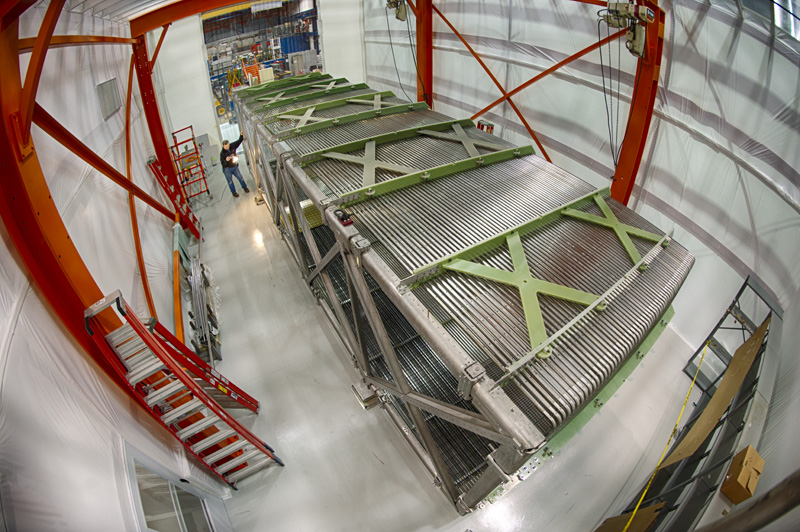
MicroBooNE features state-of-the-art particle detection techniques and technology. The experiment studies neutrino interactions and is probing models of a theorized fourth neutrino called the sterile neutrino. Photo: Reidar Hahn, Fermilab
2.) Excavated caverns and built detector components for DUNE
More than 1,400 scientists and engineers in over 30 countries collaborate on the international Deep Underground Neutrino Experiment to unlock the mysteries of neutrinos. Excavation of the large caverns of the Long-Baseline Neutrino Facility, which will house DUNE, is almost 50% complete. A two-minute animation, released this year, shows the size of the gigantic LBNF caverns for DUNE as well as one of the DUNE detector modules that will be installed. When excavation is complete, the caverns will provide space for several detector modules filled with a combined 70,000 tons of liquid argon. Mass production of detector components for DUNE has begun. This fall, the DUNE team and its partners stress-tested the logistics of shipping and handling the delicate, 20-foot-long anode plane assemblies, or APAs, for the DUNE far detector. They produced the APAs at UK’s Daresbury Laboratory and tested them at CERN, then shipped them to South Dakota.
A team comprising personnel from Fermilab, CERN and Sanford Underground Research Facility successfully lowered two APAs a mile underground. DUNE will ship 150 of these components — 136 built in the UK and 14 built in the U.S. — to South Dakota to build the first DUNE neutrino detector module. Construction of prototype components for the DUNE near detector, which will be installed at Fermilab, took place as well this year. The first near detector prototype, known as ArgonCube, was shipped from the University of Bern in Switzerland to Fermilab for installation and testing in one of the lab’s existing neutrino beams. In order to handle the intense neutrino rates expected in the future LBNF neutrino beam, one of the innovations of the DUNE near detector is the use of pixelated electronics being developed at Lawrence Berkeley National Laboratory.

The international LBNF/DUNE team with its partners recently tested the logistics of shipping and handling the large detector components that will make up the far-site detector of the Deep Underground Neutrino Experiment. On Wednesday, Nov. 2, personnel at the Sanford Underground Research Facility successfully lowered a 25-foot-long detector component for DUNE a mile underground. This was a full-scale prototype assembled and tested in Europe, then shipped from CERN to South Dakota. DUNE will ship about 150 of these components to South Dakota to build the first neutrino detector module of the Deep Underground Neutrino Experiment. Photo: Matthew Kapust, Sanford Underground Research Facility
3.) Constructed first building and assembled components for first 650-MHz cryomodule for PIP-II
In April, the PIP-II project received the U.S. Department of Energy’s approval for the full PIP-II construction. PIP-II is a 215-meter-long, state-of-the-art proton accelerator that will be the new heart of Fermilab’s particle accelerator complex. The construction of the tunnel and gallery that will house the PIP-II accelerator will start in the upcoming months. In July, Fermilab finished the construction of the first building for PIP-II, the cryoplant building. It will house the cryoplant that will provide liquid helium for the superconducting section of the new accelerator. The Fermilab team also assembled the superconducting components for the first 650-megahertz cryomodule, known as the HB650 prototype cryomodule.
The 650-MHz cryomodules, which will make up the final acceleration section of PIP-II, will be assembled in the UK. They are the first of its kind and feature unprecedented acceleration gradients for 650-MHz systems. The PIP-II team successfully tested the transportation process for these cryomodules using a dummy cryomodule, which made the round trip from Fermilab to the UK. When complete, PIP-II will power the neutrino beam for LBNF/DUNE.
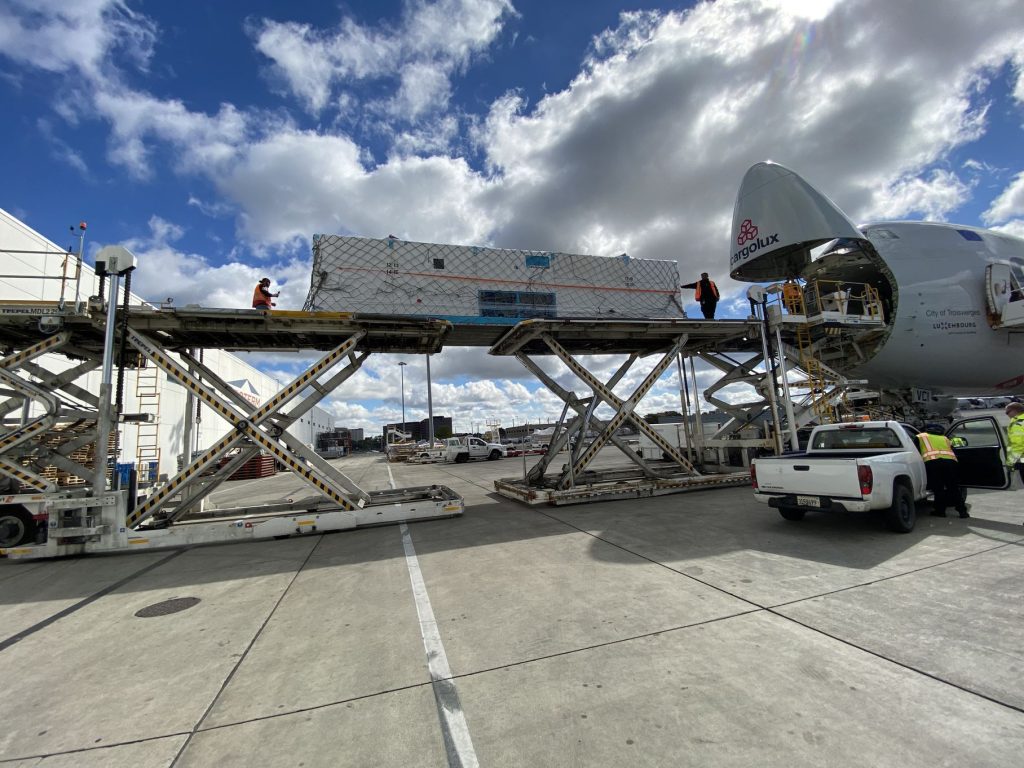
The PIP-II dummy cryomodule frame boards the cargo plane at O’Hare for its transport test. Photo: Brian Hartsell, Fermilab
4.) Advanced Fermilab’s Short-Baseline Neutrino Program
The international Short-Baseline Neutrino Program at Fermilab comprises three particle detectors: the Short-Baseline Near Detector, MicroBooNE and ICARUS. The program is devoted to examining the properties of neutrinos and the nature of neutrino oscillations in more detail than ever before. It uses the Booster Neutrino Beam produced by Fermilab’s accelerator complex. The ICARUS collaboration completed the installation of the cosmic-ray shielding for their detector and collected their first physics-quality data in June.
The SBND collaboration finished the assembly of their neutrino detection system. They moved the delicate, 20,000-pound system 3 miles across the Fermilab site to the SBN Near Detector Hall in early December. The MicroBooNE collaboration completed six years of data taking in October of last year and worked on data analysis this year. Based on half of the data they have recorded, the collaboration published stringent constraints on the existence of a sterile neutrino.
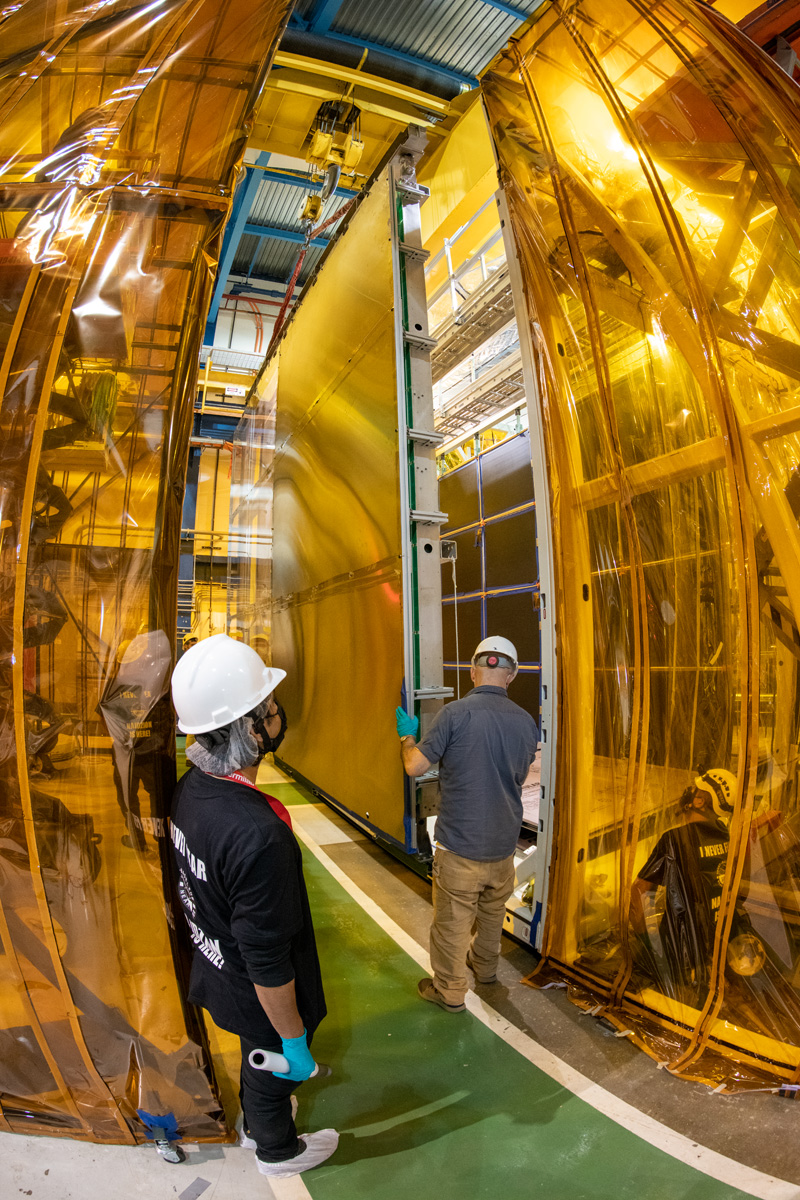
Installation of a wire plane in the neutrino detection system for the Short-Baseline Near Detector. Photo: Ryan Postel, Fermilab
5.) Started collecting more data with the CMS detector and prepared for future upgrades at the LHC
After three years of major upgrades, the Large Hadron Collider at CERN restarted operations in July. LHC Run 3 is delivering high-energy proton-proton collisions at a new record energy of 13.6 TeV. Various improvements enable scientists to collect more data than they did in the previous two runs combined. The upgraded trigger of the data acquisition system employs latest advances in high-performance computing and machine learning algorithms to handle the large volume of data from LHC collisions. US-CMS celebrated the 10-year anniversary of the discovery of the Higgs boson with a scientific symposium at Fermilab, where they also presented the results of the latest measurements of the Higgs boson’s properties by the CMS collaboration. The results were published in the journal Nature. The CMS collaboration now has published more than 1,170 scientific papers, more than any other particle physics experiment in history.
Thanks to new experimental techniques and exploitation of machine learning, the CMS collaboration has made great advances toward the discovery of pair production of the Higgs particle. The observation of this process is essential to further the understanding of the Higgs mechanism. The collaboration also is working on further upgrades to its gigantic particle detector. They are necessary for the high-luminosity operation of the LHC, which will begin later this decade. In June, US-CMS received DOE approval for the purchase of long-lead items for the upgrades of the outer tracker and the calorimeter. Together with other DOE national laboratories, Fermilab also is working on the construction and testing of superconducting magnets for the high-luminosity accelerator upgrade of the LHC.
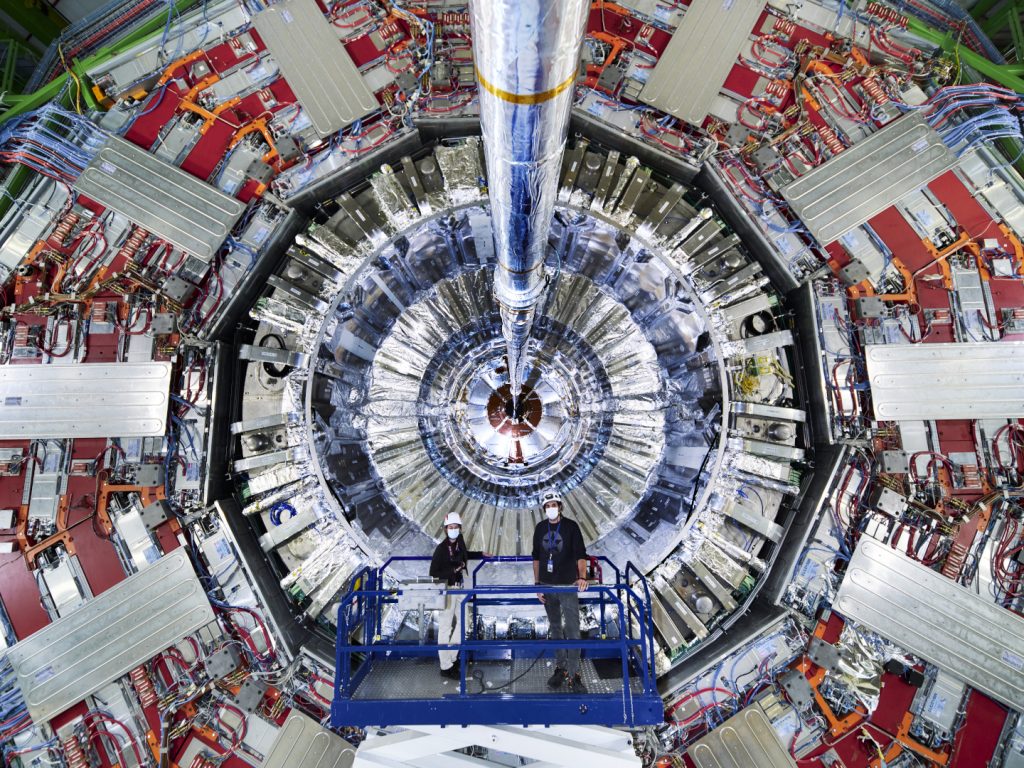
The CMS detector completed several upgrades during a three-year-long shutdown to prepare for the current physics run at the LHC. Additional upgrades planned for installation during the next long shutdown will prepare the experiment for the High-Luminosity LHC. Photo: Samuel Joseph Hertzog, CERN
6.) Advanced quantum information science
The Superconducting Quantum Materials and Systems Center, hosted by Fermilab, has grown to a collaboration of more than 400 experts from 24 partner institutions. Research at the SQMS Center focuses on advances in materials and qubit devices all the way to deploying beyond state-of-the-art quantum computing and sensing platforms. Highlights of recent material research include identification of silicon as a major contributor to performance limitations in superconducting quantum processors, together with oxides and interfaces. SQMS is translating this knowledge into improved devices through a national nanofabrication taskforce and through engineering new noise reduction devices. Researchers also made progress toward building the world’s largest, most powerful dilution refrigerator at Fermilab, which will provide unprecedented space for a quantum computer and other physics experiments.
Research in fundamental physics included achieving the world’s deepest sensitivity in a dark photon dark matter search, demonstrating that a network of entangled cavity sensors will enhance the sensitivity of dark matter searches, and testing quantum foundations on quantum computers. Members of the Fermi Quantum Institute, in collaboration with other institutions, are building a quantum network in the greater Chicago metropolitan area. The network initially connects Fermilab and Argonne. The team achieved record synchronization of signals between the two laboratories with accuracy better than 5 picoseconds, or 5 trillionths of a second. A new system of control and readout electronics developed at Fermilab, known as the Quantum Instrumentation Control Kit, or QICK, improves quantum computer performance while cutting the cost of control equipment. As part of DOE’s QuantISED program, Fermilab scientists also explore the detection of dark matter using superconducting qubits as sensors.
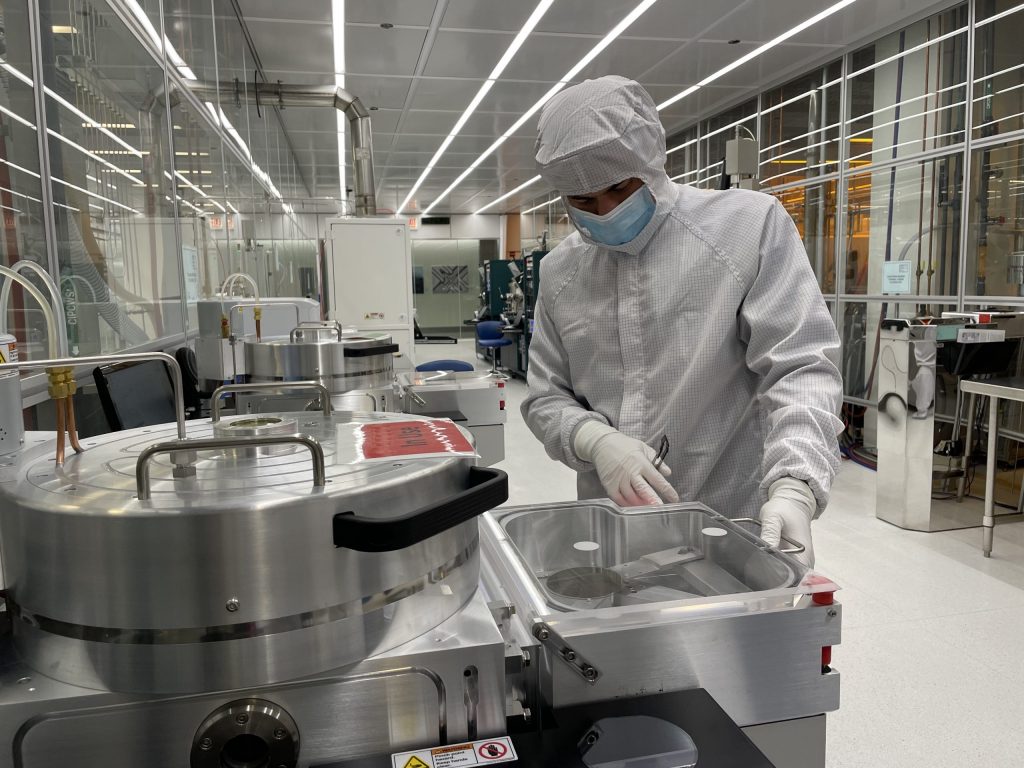
Francesco Crisa, a doctoral student at the SQMS Center, prepares to create Josephson junction patterns in an electron beam lithography system. Photo: SQMS Center
7.) Assembled magnets and detector components for the Mu2e experiment
An international group of scientists, engineers and technicians is advancing the construction of the new muon-to-electron-conversion experiment, known as Mu2e, at Fermilab. They are building detector components, assembling magnets, upgrading particle accelerators and testing the beamline that will deliver a high-intensity proton beam to the Mu2e target station. Experimenters at Fermilab are assembling the Mu2e tracker and the calorimeter, which will be used to precisely measure the momentum and energy of muon decays to search for new physics. Researchers have successfully tested and measured the calorimeter’s timing to within 100 picoseconds, or 100 trillionths of a second.
Fabrication of modules for the cosmic-ray veto system, critical for rejecting background events, takes place at U.S. partner institutions and is nearly complete. International partners are making progress with other essential components of the Mu2e detector. Accelerator operators at Fermilab successfully delivered protons through the beamline to an absorber just upstream of the Mu2e target area. The fabrication of the production target, which will create the muons for the experiment, as well as the stopping target, which will capture the muons, is complete. Researchers are finishing the assembly of the transport solenoid, which will guide the muons from the production target to the stopping target. Scientists expect to begin installation and commissioning of the experiment in 2024 and take data in 2026.
8.) Completed the new engineering research center
In October, Fermilab received authorization for use and possession of the new Integrated Engineering Research Center. The new facility is funded through the Science Laboratory Infrastructure Program of the DOE Office of Science. At 80,000 square feet, the IERC is the largest purpose-built laboratory and office building at Fermilab since Wilson Hall was completed in 1974. It will be the new home for engineers and technicians from across the laboratory and offer direct access to Wilson Hall and the research groups hosted there.
The building’s systems and design make it one of the cornerstones of Fermilab’s sustainability push across the lab. A bill to name the building after the late Helen Edwards has been introduced in the U.S. Senate and House of Representatives. Edwards worked at Fermilab for 40 years and oversaw the design, construction, commissioning and operation of the Tevatron particle collider.
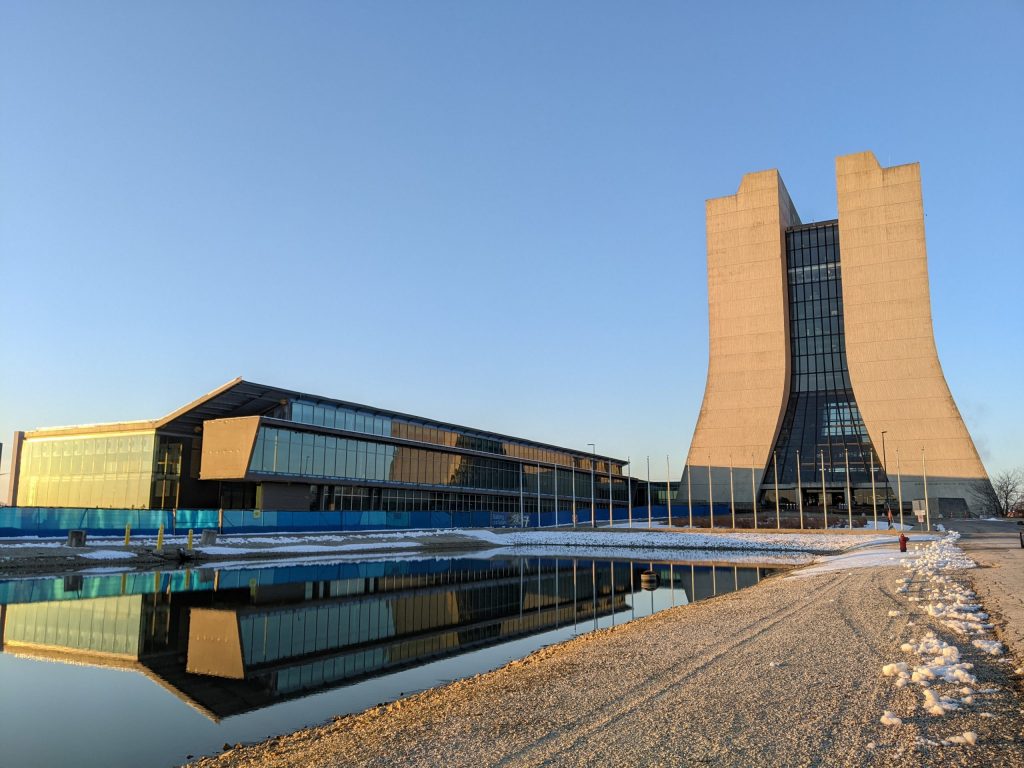
The architect’s design concept for the roof of IERC to mimic the shape of Wilson Hall (rotated 90 degrees) is evident in the pond’s reflection. Photo: Brian Rubik, Fermilab
9.) Strengthened its commitment to equity, diversity and inclusion
In 2022, Fermilab introduced a $4-million workforce development program to train and hire more U.S. veterans and members of the Junior Reserve Officers’ Training Corps. The new Accelerator Science Program to Increase Representation in Engineering, or ASPIRE, open to engineering students from underrepresented backgrounds, selected its first cohort of six students and supported them with 15-to-18-month internships. It was also the first year that a group officially represented Fermilab in the Chicago and Aurora Pride Parades.
The laboratory also recognized Juneteenth and celebrated Heritage Months organized by various Laboratory Resource Groups. Fermilab launched a new group, called Fermi Accessibility Communities, in July, which coincided with the 32nd anniversary of the Americans with Disabilities Act.
10.) Delivered STEM education to households near and far
Fermilab continued to offer many online STEM education and public engagement programs in 2022. Since March, the Fermilab site also is again open to the public. This year, the Leon Lederman Science Education Center celebrated its 30-year anniversary. The new MakerSpace at the center gives students, teachers and all other visitors access to technologies such as 3D printers, digital cutters and robotics. It is a space where learners of different backgrounds, ages and interests can share ideas, be innovative and build their own knowledge, all inspired by Fermilab science.
Programs that currently take place at the MakerSpace include Visualizing STEM and Science Accelerating Girls’ Engagement in STEM. The construction of the Fermilab Timeline exhibit outside the Lederman Science Center, which uses the existing Fermilab particle accelerator paths, is underway. But you don’t have to come to Fermilab in person to learn more about the laboratory. About one million people follow Fermilab’s social media channels. Videos, animations and lectures on the Fermilab YouTube channel have received a total of almost 10 million views this year.
Fermi National Accelerator Laboratory is supported by the Office of Science of the U.S. Department of Energy. The Office of Science is the single largest supporter of basic research in the physical sciences in the United States and is working to address some of the most pressing challenges of our time. For more information, please visit science.energy.gov.




